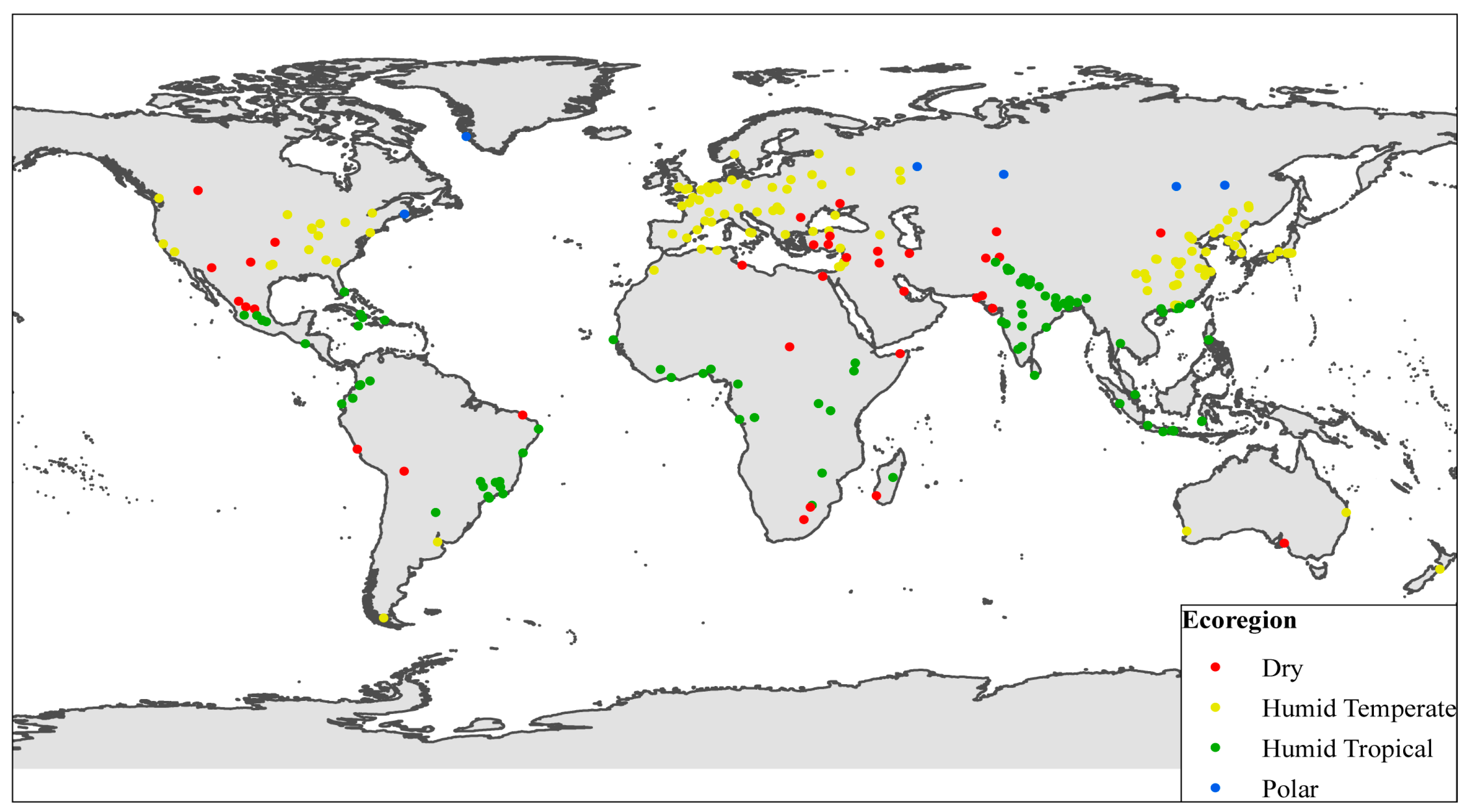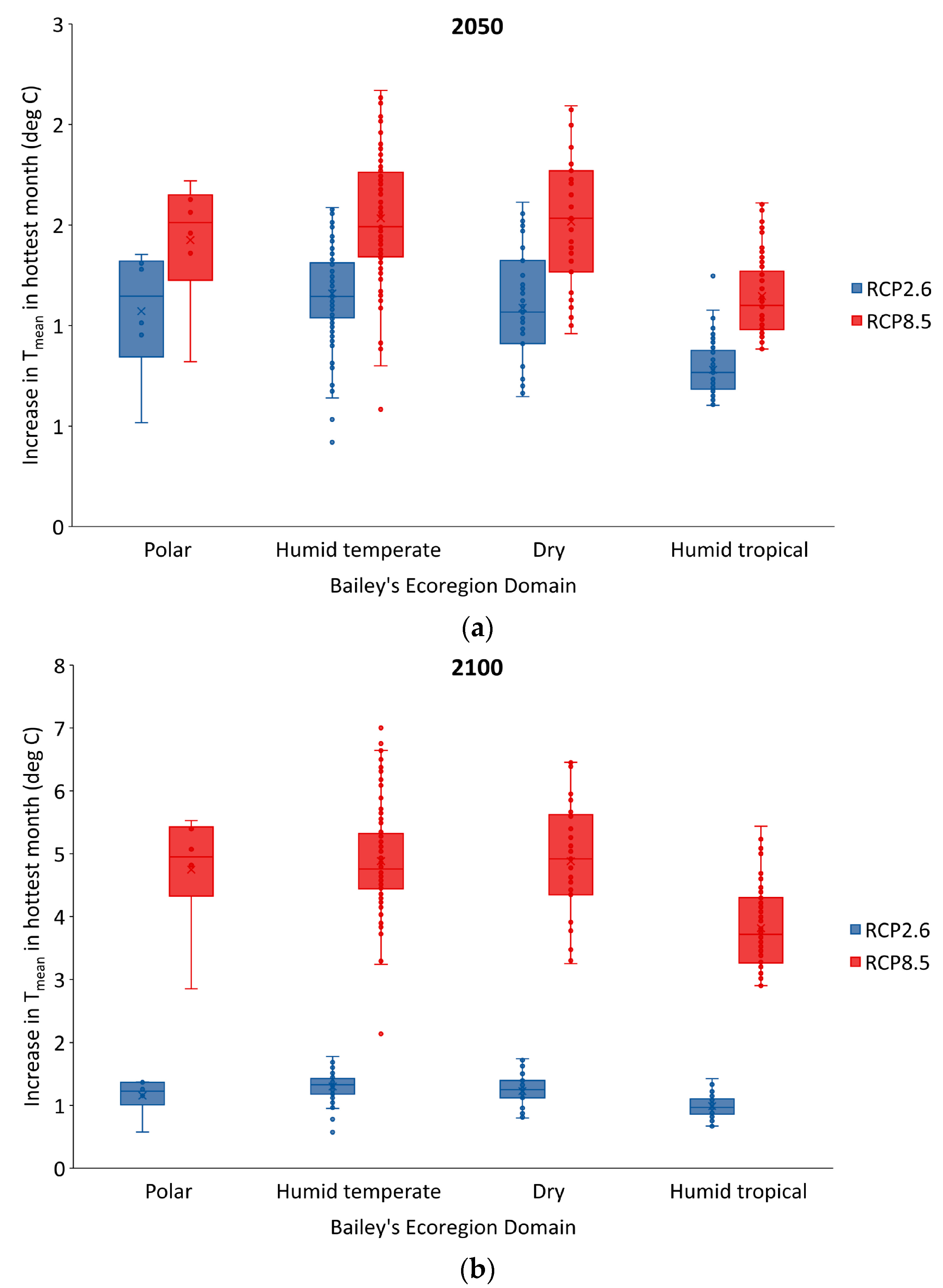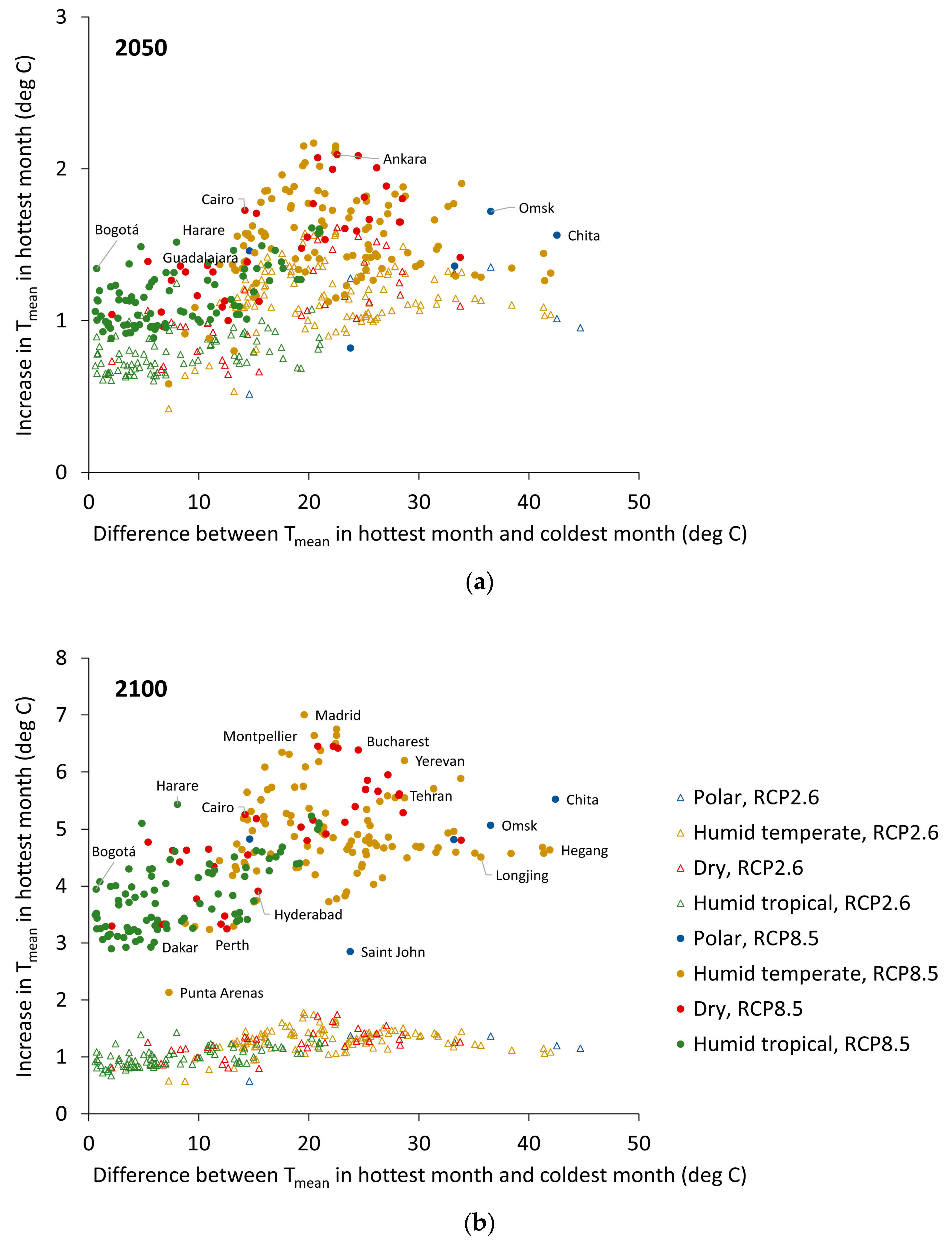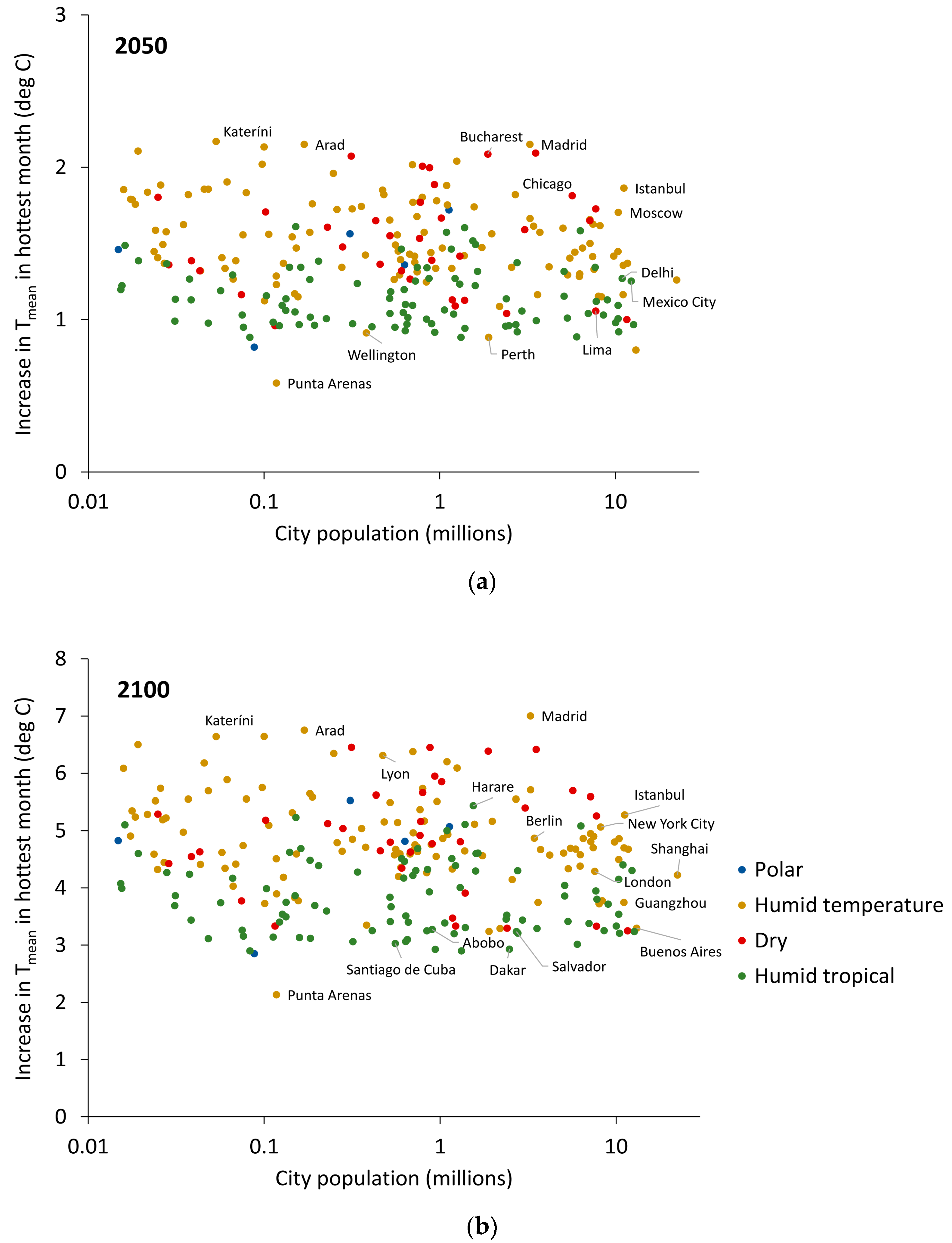The Challenge of Urban Heat Exposure under Climate Change: An Analysis of Cities in the Sustainable Healthy Urban Environments (SHUE) Database
Abstract
1. Introduction
2. Materials and Methods
2.1. Temperature-Related Climate Change Risk
2.2. City-Level Characteristics
- Location: the coordinates (latitude and longitude) of each city obtained from GeoNames [9].
- Population size: estimates of city populations obtained from GeoNames.
2.3. Analyses
3. Results
3.1. Temperature Changes by 2050 and 2100
3.2. Variations in Temperature Change by Latitude, Ecoregion Domain, and City Size
4. Discussion
Supplementary Materials
Acknowledgment
Author Contributions
Conflicts of Interest
References
- United Nations. World Urbanization Prospects. The 2014 Revision; UN Department of Economic and Social Affairs: New York, NY, USA, 2014. [Google Scholar]
- New Climate Economy. Seizing the Global Opportunity: Partnerships for Better Growth and a Better Climate; New Climate Economy: Washington, DC, USA, 2015. [Google Scholar]
- Haines, A.; McMichael, A.J.; Smith, K.R.; Roberts, I.; Woodcock, J.; Markandya, A.; Armstrong, B.G.; Campbell-Lendrum, D.; Dangour, A.D.; Davies, M.; et al. Public health benefits of strategies to reduce greenhouse-gas emissions: Overview and implications for policy makers. Lancet 2009, 374, 2104–2114. [Google Scholar] [CrossRef]
- Hajat, S.; Vardoulakis, S.; Heaviside, C.; Eggen, B. Climate change effects on human health: Projections of temperature-related mortality for the UK during the 2020s, 2050s and 2080s. J. Epidemiol. Commun. Health 2014, 68, 595–596. [Google Scholar] [CrossRef] [PubMed]
- IPCC. Climate Change 2013: The Physical Science Basis. Contribution of Working Group I to the Fifth Assessment Report of the Intergovernmental Panel on Climate Change; Cambridge University Press: Cambridge, UK; New York, NY, USA, 2014. [Google Scholar]
- Ekström, E.; Grose, M.R.; Whetton, P.H. An appraisal of downscaling methods used in climate change research. Wiley Interdiscip. Rev. Clim. Chang. 2015, 6, 301–319. [Google Scholar] [CrossRef]
- Giorgi, F.; Gutowski, W.J. Regional dynamical downscaling and the CORDEX initiative. Ann. Rev. Environ. Resour. 2015, 40, 467–490. [Google Scholar] [CrossRef]
- Milner, J.; Taylor, J.; Barreto, M.L.; Davies, M.; Haines, A.; Harpham, C.; Sehgal, M.; Wilkinson, P.; on behalf of the SHUE project partners. Environmental risks of cities in the European Region: Analyses of the Sustainable Healthy Urban Environments (SHUE) database. Public Health Panor. 2017, 3, 141–356. [Google Scholar]
- GeoNames. The GeoNames Geographical Database. Available online: http://www.geonames.org/ (accessed on 1 March 2017).
- World Bank. GNI Per Capita. Available online: http://data.worldbank.org/indicator/NY.GNP.PCAP.PP.CD (accessed on 1 March 2017).
- Bailey, R.G. Ecoregions: The Ecosystem Geography of the Oceans and Continents; Springer: New York, NY, USA, 1998. [Google Scholar]
- Van Vuuren, D.P.; Edmonds, J.; Kainuma, M.; Riahi, K.; Thomson, A.; Hibbard, K.; Hurtt, G.C.; Kram, T.; Krey, V.; Lamarque, J.-F.; et al. The representative concentration pathways: An overview. Clim. Chang. 2011, 109, 5. [Google Scholar] [CrossRef]
- Meinshausen, M.; Smith, S.J.; Calvin, K.; Daniel, J.S.; Kainuma, M.L.T.; Lamarque, J.-F.; Matsumoto, K.; Montzka, S.A.; Raper, S.C.B.; Riahi, K.; et al. The RCP greenhouse gas concentrations and their extensions from 1765 to 2300. Clim. Chang. 2011, 109, 213. [Google Scholar] [CrossRef]
- International Institute for Applied Systems Research (IIASA). RCP Database (version 2.0). Available online: http://tntcat.iiasa.ac.at:8787/RcpDb/dsd?Action=htmlpage&page=welcome (accessed on 1 September 2016).
- Riahi, K.; Gruebler, A.; Nakicenovic, N. Scenarios of long-term socio-economic and environmental development under climate stabilization. Technol. Forecast. Soc. Chang. 2007, 74, 887–935. [Google Scholar] [CrossRef]
- Taylor, K.; Stouffer, R.; Meehl, G. An overview of CMIP5 and the experiment design. Bull. Am. Meteorol. Soc. 2012, 93, 485–498. [Google Scholar] [CrossRef]
- Collins, M.; Knutti, R.; Arblaster, J.; Dufresne, J.-L.; Fichefet, T.; Friedlingstein, P.; Gao, X.; Gutowski, W.J.; Johns, T.; Krinner, G.; et al. Long-term climate change: Projections, commitments and irreversibility. In Climate Change 2013: The Physical Science Basis. Contribution of Working Group I to the Fifth Assessment Report of the Intergovernmental Panel on Climate Change; Stocker, T.F., Qin, D., Plattner, G.-K., Tignor, M., Allen, S.K., Boschung, J., Nauels, A., Xia, Y., Bex, V., Midgley, P.M., Eds.; Cambridge University Press: Cambridge, UK; New York, NY, USA, 2013. [Google Scholar]
- Harris, I.; Jones, P.D.; Osborn, T.J.; Lister, D.H. Updated high-resolution grids of monthly climatic observations—The CRU TS3.10 Dataset. Int. J. Climatol. 2014, 34, 623–642. [Google Scholar] [CrossRef]
- Flato, G.; Marotzke, J.; Abiodun, B.; Braconnot, P.; Chou, S.C.; Collins, W.; Cox, P.; Driouech, F.; Emori, S.; Eyring, V.; et al. Evaluation of climate models. In Climate Change 2013: The Physical Science Basis. Contribution of Working Group I to the Fifth Assessment Report of the Intergovernmental Panel on Climate Change; Stocker, T.F., Qin, D., Plattner, G.-K., Tignor, M., Allen, S.K., Boschung, J., Nauels, A., Xia, Y., Bex, V., Midgley, P.M., Eds.; Cambridge University Press: Cambridge, UK; New York, NY, USA, 2013. [Google Scholar]
- Gasparrini, A.; Guo, Y.; Hashizume, M.; Lavigne, E.; Zanobetti, A.; Schwartz, J.; Tobias, A.; Tong, S.; Rocklov, J.; Forsberg, B.; et al. Mortality risk attributable to high and low ambient temperature: A multicountry observational study. Lancet 2015, 386, 369–375. [Google Scholar] [CrossRef]
- McMichael, A.J.; Wilkinson, P.; Kovats, R.S.; Pattenden, S.; Hajat, S.; Armstrong, B.; Vajanapoom, N.; Niciu, E.M.; Mahomed, H.; Kingkeow, C.; et al. International study of temperature, heat and urban mortality: The “ISOTHURM” project. Int. J. Epidemiol. 2008, 37, 1121–1131. [Google Scholar] [CrossRef] [PubMed]
- Medina-Ramon, M.; Schwartz, J. Temperature, temperature extremes, and mortality: A study of acclimatisation and effect modification in 50 US cities. Occup. Environ. Med. 2007, 64, 827–833. [Google Scholar] [CrossRef] [PubMed]
- Bunker, A.; Wildenhain, J.; Vandenbergh, A.; Henschke, N.; Rocklov, J.; Hajat, S.; Sauerborn, R. Effects of air temperature on climate-sensitive mortality and morbidity outcomes in the elderly; a systematic review and meta-analysis of epidemiological evidence. EBioMedicine 2016, 6, 258–268. [Google Scholar] [CrossRef] [PubMed]
- Brode, P.; Fiala, D.; Lemke, B.; Kjellstrom, T. Estimated work ability in warm outdoor environments depends on the chosen heat stress assessment metric. Int. J. Biometeorol. 2017. [Google Scholar] [CrossRef] [PubMed]
- Gao, C.; Kuklane, K.; Ostergren, P.O.; Kjellstrom, T. Occupational heat stress assessment and protective strategies in the context of climate change. Int. J. Biometeorol. 2017. [Google Scholar] [CrossRef] [PubMed]
- Lomas, K.J.; Porritt, S.M. Overheating in buildings: Lessons from research. Build. Res. Inf. 2017, 45, 1–18. [Google Scholar] [CrossRef]
- Nilsson, M.; Kjellstrom, T. Climate change impacts on working people: How to develop prevention policies. Glob. Health Action 2010, 3, 5774. [Google Scholar] [CrossRef] [PubMed]
- Ward, K.; Lauf, S.; Kleinschmit, B.; Endlicher, W. Heat waves and urban heat islands in Europe: A review of relevant drivers. Sci. Total Environ. 2016, 569–570, 527–539. [Google Scholar] [CrossRef] [PubMed]
- Estoque, R.C.; Murayama, Y.; Myint, S.W. Effects of landscape composition and pattern on land surface temperature: An urban heat island study in the megacities of Southeast Asia. Sci. Total Environ. 2017, 577, 349–359. [Google Scholar] [CrossRef] [PubMed]
- Zhou, B.; Rybski, D.; Kropp, J.P. The role of city size and urban form in the surface urban heat island. Sci. Rep. 2017, 7. [Google Scholar] [CrossRef] [PubMed]
- Heaviside, C.; Macintyre, H.; Vardoulakis, S. The urban heat island: Implications for health in a changing environment. Curr. Environ. Health Rep. 2017, 4, 296–305. [Google Scholar] [CrossRef] [PubMed]
- Milojevic, A.; Armstrong, B.G.; Gasparrini, A.; Bohnenstengel, S.I.; Barratt, B.; Wilkinson, P. Methods to estimate acclimatization to urban heat island effects on heat- and cold-related mortality. Environ. Health Perspect. 2016, 124, 1016–1022. [Google Scholar] [CrossRef] [PubMed]
- Lindberg, F.; Holmer, B.; Thorsson, S.; Rayner, D. Characteristics of the mean radiant temperature in high latitude cities—Implications for sensitive climate planning applications. Int. J. Biometeorol. 2014, 58, 613–627. [Google Scholar] [CrossRef] [PubMed]






| WHO Region 1 | Ecoregion Domain | Cities |
|---|---|---|
| Africa | Polar | (none) |
| Humid temperate | Algiers, Didouche Mourad | |
| Dry | Benoni, Thaba Nchu, Toliara | |
| Humid tropical | Abobo, Addis Ababa, Antananarivo, Dakar, Ekangala, Harare, Hawassa, Ikerre, Kinshasa, Lagos, Ntungamo, Pointe-Noire, Usagara, Vavoua, Yaoundé | |
| Americas | Polar | Saint John |
| Humid temperate | Alpharetta, Augusta, Benicia, Buenos Aires, Calumet City, Carmel, Chicago, Coon Rapids, Corcoran, Fort Worth, Grand Rapids, Hamilton, Montréal, Murray, New York City, Plano, Punta Arenas, Richmond | |
| Dry | Calgary, Cochabamba, Emporia, Fortaleza, Jerez de García Salinas, Lima, Lubbock, San Luis Potosí, Tucson, Victoria de Durango | |
| Humid tropical | Álvaro Obregón, Barbacena, Belo Horizonte, Bogotá, Cali, Conceição das Alagoas, Corrientes, Deerfield Beach, Divinópolis, El Cerrito, Guadalajara, Holguín, Ibarra, João Pessoa, Kingston, Manta, Mexico City, Puebla, Ribeirão Preto, Rio de Janeiro, Salvador, San Salvador, Santiago de Cuba, Santiago de los Caballeros, Santiago de Querétaro, Santos, São Paulo | |
| Eastern Mediterranean | Polar | (none) |
| Humid temperate | Damascus, Marrakesh, Qatana | |
| Dry | Baghdad, Bosaso, Cairo, Dammam, Erbil, Homs, Hyderabad, Kabul, Karachi, Mingora, Sabratah, Tehran, Zalingei | |
| Humid tropical | Gujranwala, Kohat, Lahore | |
| Europe | Polar | Chita, Izhevsk, Nuuk, Omsk |
| Humid temperate | Adana, Arad, Berlin, Bressanone, Brunoy, Cava Dè Tirreni, Düsseldorf, Farnborough, Gloucester, Gomel, Hadera, Hamburg, Hrodna, Istanbul, Karabük, Kateríni, Kazan, Leczna, Le Grand-Quevilly, Le Mans, Lódz, London, Lyepyel, Lyon, Madrid, Marseille, Mezotúr, Montpellier, Moscow, Namur, Nantes, Napoli, Oostend, Oslo, Rotterdam, Saint Petersburg, Sant Vicenç dels Horts, Simferopol, Subotica, Tolyatti, Valencia, Vercelli, Voorst, Yerevan, Zagreb | |
| Dry | Ankara, Bucharest, Denizli, Konya, Namangan, Zaporizhzhya | |
| Humid tropical | (none) | |
| South-East Asia | Polar | (none) |
| Humid temperate | Hamhung, Songnim | |
| Dry | Rajkot | |
| Humid tropical | Amravati, Amritsar, Bahraich, Bangalore, Bangkok, Bareilly, Bhopal, Bidar, Budaun, Buduran, Chaibasa, Delhi, Dhaka, Durgapur, Galesong, Hailakandi, Haldwani, Hisua, Jakarta, Laksar, Makassar, Matara, Meerut, Mojokerto, Mumbai, Mysore, Padang, Pasuruan, Pune, Rajshahi, Ranchi, Shantipur, Shrirampur, Varanasi, Visakhapatnam, Yogyakarta | |
| Western Pacific | Polar | Tahe |
| Humid temperate | Beijing, Brisbane, Changchun, Changzhou, Chengdu, Chongqing, Daegu, Dongguan, Foshan, Guangzhou, Guankou, Guiyang, Hangzhou, Harbin, Hegang, Ikoma, Jiamusi, Langfang, Longjing, Nagareyama, Nanchong, Nanjing, Narita, Ome, Perth, Pingdingshan, Qingdao, Seoul, Shanghai, Shenyang, Suzhou, Tai’an, Takayama, Tianjin, Tokyo, Wellington, Wuhan, Xi’an, Xiangtan, Xianyang, Yingkou, Zhoukou, Zhumadian, | |
| Dry | Adelaide, Baotou | |
| Humid tropical | Danshui, Hong Kong, Macau, Manila, Shantou, Shenzhen, Singapore, Quezon City, Yashan, Zhanjiang |
| Global Climate Model Acronym | Original Model Resolution (Number of Latitude × Longitude Cells) |
|---|---|
| CCSM4 | 192 × 288 |
| CNRM-CM5 | 128 × 256 |
| CSIRO-Mk3-6-0 | 96 × 192 |
| CanESM2 | 64 × 128 |
| GFDL-CM3 | 90 × 144 |
| GFDL-ESM2G | 90 × 144 |
| HadGEM2-ES | 145 × 192 |
| IPSL-CM5A-LR | 96 × 96 |
| IPSL-CM5A-MR | 143 × 144 |
| MIROC-ESM | 64 × 128 |
| MIROC-ESM-CHEM | 64 × 128 |
| MIROC5 | 128 × 256 |
| MPI-ESM-LR | 96 × 192 |
| MPI-ESM-MR | 96 × 192 |
| MRI-CGCM3 | 160 × 320 |
| NorESM1-M | 96 × 144 |
| bcc-csm1-1 | 64 × 128 |
| bcc-csm1-1-m | 160 × 320 |
| WHO Region | Ecoregion Domain | Cities | 2050 | 2100 | ||||||||||
|---|---|---|---|---|---|---|---|---|---|---|---|---|---|---|
| RCP2.6 | RCP8.5 | RCP2.6 | RCP8.5 | |||||||||||
| Mean (°C) | Coldest Month (°C) | Hottest Month (°C) | Mean (°C) | Coldest Month (°C) | Hottest Month (°C) | Mean (°C) | Coldest Month (°C) | Hottest Month (°C) | Mean (°C) | Coldest Month (°C) | Hottest Month (°C) | |||
| Africa | Polar | 0 | - | - | - | - | - | - | - | - | - | - | - | - |
| Humid temperate | 2 | 0.95 | 0.70 | 1.24 | 1.32 | 1.08 | 1.72 | 1.09 | 0.82 | 1.36 | 4.23 | 3.27 | 5.45 | |
| Dry | 3 | 0.87 | 0.86 | 0.84 | 1.26 | 1.27 | 1.22 | 1.04 | 0.97 | 1.13 | 4.23 | 4.01 | 4.08 | |
| Humid tropical | 15 | 0.80 | 0.79 | 0.82 | 1.15 | 1.14 | 1.16 | 0.94 | 0.89 | 1.00 | 3.79 | 3.74 | 3.87 | |
| Americas | Polar | 1 | 1.26 | 1.49 | 1.28 | 1.59 | 1.79 | 1.63 | 1.50 | 1.96 | 1.37 | 5.03 | 5.78 | 5.39 |
| Humid temperate | 18 | 1.05 | 1.04 | 1.14 | 1.42 | 1.48 | 1.54 | 1.25 | 1.39 | 1.26 | 4.44 | 4.41 | 4.90 | |
| Dry | 10 | 0.97 | 0.91 | 1.01 | 1.35 | 1.33 | 1.41 | 1.12 | 1.17 | 1.14 | 4.36 | 4.11 | 4.64 | |
| Humid tropical | 27 | 0.77 | 0.74 | 0.76 | 1.10 | 1.02 | 1.09 | 0.92 | 0.87 | 0.94 | 3.61 | 3.41 | 3.65 | |
| Eastern Mediterranean | Polar | 0 | - | - | - | - | - | - | - | - | - | - | - | - |
| Humid temperate | 3 | 0.97 | 0.75 | 1.18 | 1.35 | 1.16 | 1.58 | 1.12 | 0.92 | 1.33 | 4.30 | 3.52 | 4.87 | |
| Dry | 13 | 0.99 | 0.98 | 1.08 | 1.37 | 1.30 | 1.52 | 1.17 | 1.15 | 1.22 | 4.54 | 4.27 | 4.89 | |
| Humid tropical | 3 | 0.94 | 1.13 | 0.94 | 1.49 | 1.46 | 1.60 | 1.24 | 1.28 | 1.28 | 5.06 | 5.07 | 5.14 | |
| Europe | Polar | 4 | 1.25 | 1.46 | 1.05 | 1.64 | 1.61 | 1.39 | 1.41 | 1.76 | 1.10 | 5.37 | 6.49 | 4.57 |
| Humid temperate | 45 | 0.99 | 0.85 | 1.31 | 1.34 | 1.24 | 1.72 | 1.16 | 1.14 | 1.38 | 4.20 | 3.99 | 5.35 | |
| Dry | 6 | 1.08 | 0.91 | 1.48 | 1.48 | 1.27 | 1.98 | 1.27 | 1.27 | 1.54 | 4.75 | 4.10 | 6.17 | |
| Humid tropical | 0 | - | - | - | - | - | - | - | - | - | - | - | - | |
| South-East Asia | Polar | 0 | - | - | - | - | - | - | - | - | - | - | - | - |
| Humid temperate | 2 | 1.13 | 1.28 | 1.13 | 1.44 | 1.50 | 1.48 | 1.28 | 1.40 | 1.38 | 4.64 | 5.15 | 4.63 | |
| Dry | 1 | 0.77 | 1.09 | 0.71 | 1.15 | 1.36 | 1.13 | 0.95 | 1.20 | 0.96 | 3.83 | 4.70 | 3.47 | |
| Humid tropical | 36 | 0.73 | 0.82 | 0.78 | 1.10 | 1.16 | 1.18 | 0.95 | 1.03 | 1.02 | 3.81 | 4.04 | 3.91 | |
| Western Pacific | Polar | 1 | 1.23 | 1.43 | 0.95 | 1.65 | 1.62 | 1.36 | 1.36 | 1.44 | 1.15 | 5.39 | 6.33 | 4.82 |
| Humid temperate | 43 | 1.05 | 1.13 | 1.01 | 1.35 | 1.38 | 1.32 | 1.22 | 1.26 | 1.22 | 4.38 | 4.53 | 4.36 | |
| Dry | 2 | 0.94 | 0.94 | 0.92 | 1.25 | 1.16 | 1.25 | 1.04 | 0.96 | 1.07 | 4.04 | 3.93 | 4.07 | |
| Humid tropical | 10 | 0.76 | 0.74 | 0.73 | 1.05 | 1.10 | 1.04 | 0.97 | 1.03 | 0.89 | 3.41 | 3.38 | 3.42 | |
© 2017 by the authors. Licensee MDPI, Basel, Switzerland. This article is an open access article distributed under the terms and conditions of the Creative Commons Attribution (CC BY) license (http://creativecommons.org/licenses/by/4.0/).
Share and Cite
Milner, J.; Harpham, C.; Taylor, J.; Davies, M.; Le Quéré, C.; Haines, A.; Wilkinson, P. The Challenge of Urban Heat Exposure under Climate Change: An Analysis of Cities in the Sustainable Healthy Urban Environments (SHUE) Database. Climate 2017, 5, 93. https://doi.org/10.3390/cli5040093
Milner J, Harpham C, Taylor J, Davies M, Le Quéré C, Haines A, Wilkinson P. The Challenge of Urban Heat Exposure under Climate Change: An Analysis of Cities in the Sustainable Healthy Urban Environments (SHUE) Database. Climate. 2017; 5(4):93. https://doi.org/10.3390/cli5040093
Chicago/Turabian StyleMilner, James, Colin Harpham, Jonathon Taylor, Mike Davies, Corinne Le Quéré, Andy Haines, and Paul Wilkinson. 2017. "The Challenge of Urban Heat Exposure under Climate Change: An Analysis of Cities in the Sustainable Healthy Urban Environments (SHUE) Database" Climate 5, no. 4: 93. https://doi.org/10.3390/cli5040093
APA StyleMilner, J., Harpham, C., Taylor, J., Davies, M., Le Quéré, C., Haines, A., & Wilkinson, P. (2017). The Challenge of Urban Heat Exposure under Climate Change: An Analysis of Cities in the Sustainable Healthy Urban Environments (SHUE) Database. Climate, 5(4), 93. https://doi.org/10.3390/cli5040093






